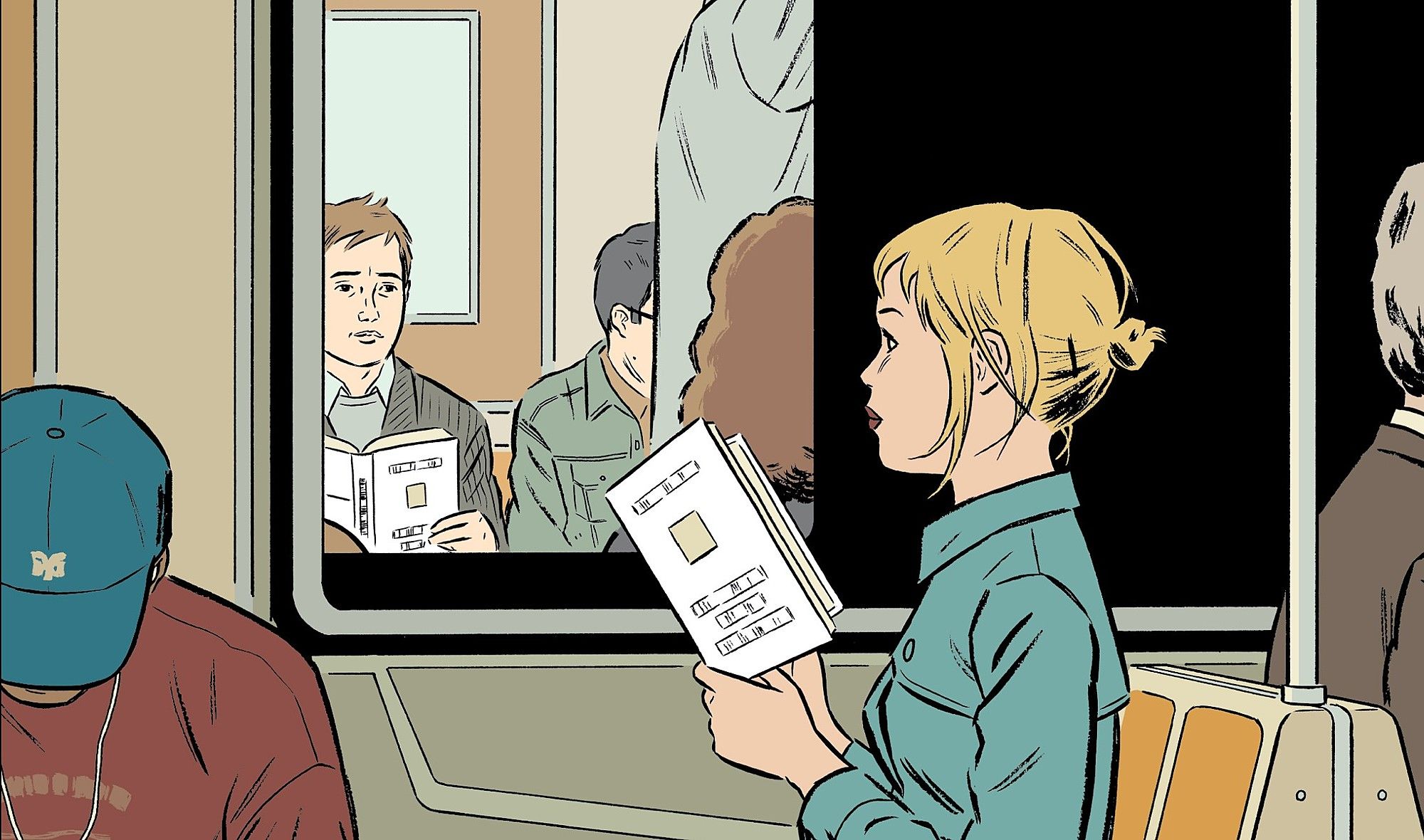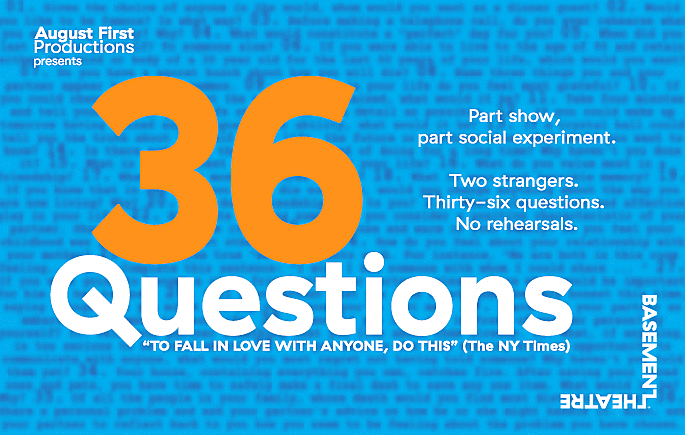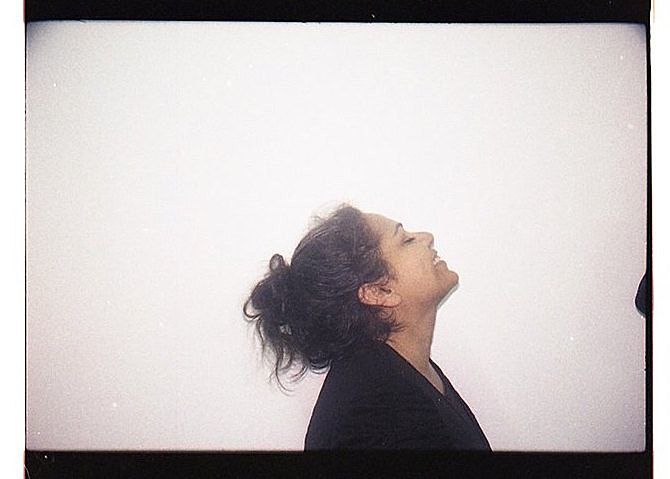36 Ruminations on 36 Questions
What happens when you attempt to make two strangers fall in love, live onstage? Nisha Madhan responds to the recent experiment that took place at the Basement Theatre.
1. 36 Questions
There is an article in The New York Times called To Fall in Love With Anyone, Do This. It details a psychological study developed twenty years ago by Arthur Aron, in which strangers were invited into a room to ask each other a set of 36 questions. Aron’s study, entitled ‘The Experimental Generation of Interpersonal Closeness: A Procedure and Some Preliminary Findings’ was conducted to “create closeness in an experimental context” through this specifically designed set of questions. After the experiment, two of the participants fell in love and married each other.
2. Simon
Simon Ward is an actor and a writer who wants to find a meaningful connection between two people. This may or may not include himself. Simon thinks that Aron’s experiment is a good idea for a show, so Simon decided to invite two different strangers into the Basement Theatre every night over five nights to ask each other Aron’s set of 36 Questions. They may or may not fall in love, but they will ask and answer some difficult questions, witnessed by about 60 people through a perspex wall.
3. Promises
When an event happens in a theatre, it makes a promise. The promise of this event is that two strangers might fall hopelessly in love right in front of you.
4. Hopelessness
I am a person who is hopelessly in love with the theatre. I think about it as soon as I wake up. I stalk it. I worry about it. I like to imagine what it’s doing in other cities. I spend all of my money on it. I try to casually drop it into the conversation so that I can have an excuse to talk about it. I focus on it. I put time into it. I look it in the eye and I ask it some difficult questions.
5. My Favourite Question
My favourite question is number 24: How do you feel about your mother?
6. Something Meaningful
Ask almost any theatre maker what ‘good’ theatre is and they will say that ‘good’ theatre is theatre that moves you. In this sense, Simon’s theatre experiment is brilliant. It promises something we all want, especially when we go to the theatre. Moving, touching, meaningful love. We want to see real people falling in love for real and we want to fall in love with them.
Why does theatre give rise to this need for something meaningful?
We want to see real people falling in love for real and we want to fall in love with them
7. The Distance between Thinking and Feeling
Theatre likes to make you feel. It makes you think as well but it really comes into its own when it makes you feel. Sometimes too much thinking feels distant and cold. Sometimes too much feeling feels awkward and inappropriate. The distance between thinking and feeling needs to be met, otherwise the public walk out under the illusion that it was a waste of time. I say illusion, because I’m not sure that it’s theatre’s job to make you think or feel. Theatre is physically experiential and has a set amount of time to begin and end during which the audience demands a shift. And when this shift doesn’t happen, they are unsatisfied.
8. Perception
Can the theatre function as a space for shifting one’s perception? Can it make the world look different to the way it did before?
9. George and Janice at The Pompidou Centre In Paris
My husband loves to tell the story of his mother and father going to The Georges Pompidou Centre in Paris. They spent hours looking at every single piece of art on all four floors. After this they concluded that it was all a load of rubbish and they probably could have done better themselves.
They took the escalators up to the top of the building and sat in front of a fountain. It was raining. They sat and watched the rain bounce off the water in a fountain for an unknown amount of time and somehow the world seemed more beautiful than it did before. We have talked about this story at least once every year that we have known each other. Our guess is that the art in that building whether considered ‘good’ or ‘bad’ did something useful. It shifted their experience of the world. They watched the rain in a different way.
10. The Path of Least Resistance
The art in the Pompidou Centre was not specifically made to make you feel. It was made to make you think and to express the artist's social and political position in the world. So why is feeling moved in the theatre associated with the success of a work? Is feeling moved the quickest way of registering that something meaningful has taken place?
11. Simon is a Scientist
Seeing a moving piece of theatre is addictive. It releases chemicals in the brain that make you return again and again. Laughing, crying, being scared, feeling angry, falling in love are all chemical mixtures that fire about your brain. 36 Questions isn’t necessarily going for the heady mix of serotonin, dopamine and norepinephrine common with lusting after someone, but there is a chance that it could happen. Simon thought about how to create the exact right conditions for this possible outcome. He selected the participants carefully. He briefed the audience on trust and confidentiality. He warmed and dimmed the lights at certain stages. Like the questions, Simon has crafted the signs of theatre into a lab where the chemicals of closeness can mix about. Whether or not they create sparks is unknown. It has to be unknown to be an experiment.
12. Gooey Feelings
I had gooey feelings while watching the participants go through the 36 Questions. Science must have happened.
13. Flirting
Flirting is the best thing in the world. Nothing is said. Anything is possible. It is alive and intoxicating, so long as the mystery of whether it’s true or not remains unsolved. Like a good flirt, 36 Questions has a number of unknowns at play. These unknowns create space for meaning to happen. Every gesture, noise and exchange that occurs is charged with the possibility of falling in love.
Every gesture, noise and exchange that occurs is charged with the possibility of falling in love
14. Intimacy
The questions are about accelerating closeness, not lust. Taking the time and effort to focus on one another. It’s more than the addictive brew of chemicals brought on by the smell buried in the nape of someone’s neck. It’s the thinking that you do afterwards. The effort you make in choosing each other constantly. The way the world changes in relation to one another. The way your pace speeds up or slows down to accommodate the person beside you.
15. Business
The lure of love is magnetic. 36 Questions performed better on social media than other theatre companies with massive amounts of government funding towards infrastructure. What sets this theatre production apart from others, however, is that it is an experiment.
16. Experimental
That dirty word. An unviable, if not laughable, way to make art - or so older theatre-makers keep reminding me. Making experiments is counter-intuitive to running a good business and art is a business in this country. Experimenting implies an unreliable, unknown product. It thrives on having variables. How can you possibly sell a show that you don’t know will ‘work?’ I don’t know about that word ‘work.’ I don’t want to see something that ‘works.’ I want to see something that lives. Living is unpredictable. Living is not a reliable, known product. Living is not business.
I don’t want to see something that ‘works.’ I want to see something that lives. Living is unpredictable. Living is not a reliable, known product. Living is not business
17. One More Thing
An experiment is cause and effect played out through different variables. A result isn’t necessarily a success or a failure, but something that gives you more information about your initial question.
18. Presence
Like Marina Abramović's recent work The Artist Is Present, simply sitting still in a white-walled gallery and looking at a stranger in front of you has the makings of a blockbuster. No script, no character, no story and yet a very clear script, two very strong characters and a fantastic story. What makes it compelling is the unknown element unfolding in real-time before us. At its heart it is simply about connecting to one another in the present moment.
19. The Present Moment
Theatre is in love with chasing the present moment.
20. Risk
Two strangers enter a room. They risk falling in love with each other. We watch them draw and redraw the lines of investment between them. We are witnesses to an unfolding new relationship, rather than spectators to an already written one.
21. The Mechanics of Connection
Simon says: “The mechanics of connection and mutual focus are primarily what I respond to - be it as an actor, writer, or audience member...when you're both listening to each other, you're connected - you're in a state of mutual focus.”
In the theatre, humans play an elaborate game where they strive for a truthful connection in the present moment. Simon is in love with the possibility of staging and witnessing a true and basic human connection.
22. Ritual
Connections and mutual focus can make us have feelings. And having these feelings witnessed in a ritualistic manner means they hang around for longer. That they last. I should know, I married someone recently. It’s a ritual based on connection, mutual focus and witnesses. It was probably the best piece of theatre I have ever produced.
23. Witnesses
In the contract offered in 36 Questions, we are witnesses. The ritual is set. There is no entertainment here, only an awkward conversation. Simon briefs us on our role in what is a sacred pact between us and them. Simon asks us to agree to a confidentiality pact. No one disagrees.
24. Spectators
Being a witness is more fun than being a spectator. You have a job to do. You have to be there for these two people. They need you, otherwise it won’t happen. You are responsible for holding these two people as they dive head first into a vulnerable pool of pinky flirty intimate goo.
25. Uncertainty and Impatience
There’s something ethically tricky about the whole thing. The questions are personal and personal is powerful. The risk of asking and answering these questions in public is that participants may be deadly honest. So what happens if you reveal an honest answer and people end up hating you? Or end up loving you? There is an ethical responsibility in selling tickets to possibly witness someone’s intense honesty and vulnerability. This honesty and vulnerability may cause uncertainty and impatience in both participant and witness. Uncertainty and impatience both need to be gently held before, during and especially in the aftermath of proceedings. They are a baby animal held by the neck in the jaws of their mother for their own protection.
What happens if you reveal an honest answer and people end up hating you? Or end up loving you?
26. Questions and Answers
It’s interesting how the very simple game of asking questions and answering them can suck you in. It’s so predictable. Ask a question, receive an answer. But it doesn’t matter if the question is the same, the answer is always different and that’s what sucks you in. An audience loves to think about how they would answer the question.
27. Absurd, yes. Uncomfortable, no
At no point did it seem to me uncomfortable to watch two strangers search for closeness. Absurd, yes, uncomfortable, no.
28. Embarrassment
One of the questions demands an embarrassing story. You see the participant fold into a floppy heap of awkward gestures as they dig themselves a giant hole from which they can’t get out. Then you see the other participant say something equally embarrassing in a saving act of grace. This question of embarrassment allows an admission of failure and a chance for the other to admit that they failed once too.
29. Attention
The experiment invites you to pay attention to each other. The presence of witnesses heightens this attention.
30. Nervousness
In her book Last Operas and Plays, Gertrude Stein talks about a nervousness that exists before the show begins. There are many ways to think about this nervousness. I like to imagine the nervousness of the audience thinking will it be okay? Or will I hate it and want to leave but feel stuck because the only way out is across the stage?
The nervousness of the participants is palpable in this specific scenario but less clear. They are thinking will I actually fall in love with this person? Will I end up hating this person? Will the audience hate me once they find out that I am mean to my mother? Will I be boring?
The audience’s nervousness and the participants' nervousness rise as the show begins, and mingle as the show continues.
31. Relief
It is a relief to get to the end when there is so much nervousness in the room.
32. A conversation
Theatre at its bare bones is a conversation. It’s very difficult to have the conversation on your own. It may be between you and the audience, or you and another performer in front of an audience or you and one other member of the public. 36 Questions is a conversation, one-to-one in front of an audience. Sometimes conversations are easy. Sometimes they are not.
33. Escalation
Aron’s questions pull you gently in. They have a few moments of comic relief. They force you to compliment each other. To flirt. They force you to imagine yourself and your partner as a 'we'. They rise slowly in intensity and complexity. They start to talk about death. They move towards closeness in a sustained and escalating pace.
34. The Morning After
This show starts at the end. It’s the morning after we all want to know about. You imagine the text message they sent straight after the show. You imagine them calling their mothers. You imagine a whole hour and a half of When Harry Met Sally-style conversations in parks and diners culminating in a New Year’s Eve Party. You imagine they never see or speak to each other ever again. You now know too much about these two strangers. It’s like you have read their entire Facebook profile without them knowing and next time you see them you will have to pretend you know nothing about them. But you have imagined them, many times, in a close light.
This show starts at the end. It’s the morning after we all want to know about
35. Words
I think a lot about the slipperiness of words. They can be used and abused, they can misbehave, they can help you hide and avoid the point. The questions do their best to break the ice, dig deep and make you contemplate, but there’s nothing like reaching a place with someone where no words will do. When there is nothing left to say and when language fails to go any further. These four minutes seem to travel further than the entire hour and half it took to ask the questions. These minutes are a tropical island in a sea of words.
36. Silence
The experiment ends with four minutes of silence with the participants looking into each other’s eyes. It is a special silence, one that can only come after some difficult questions have been asked.
36 Questions was at
the Basement Theatre
15-19 March
Cover image: Adrian Tomine, 'Missed Connection'


